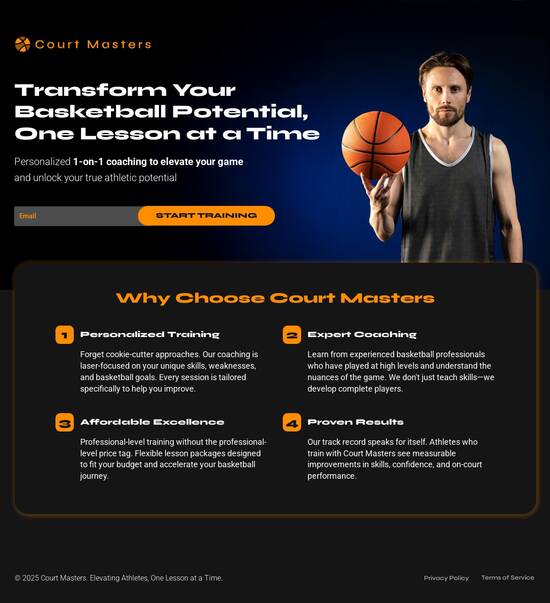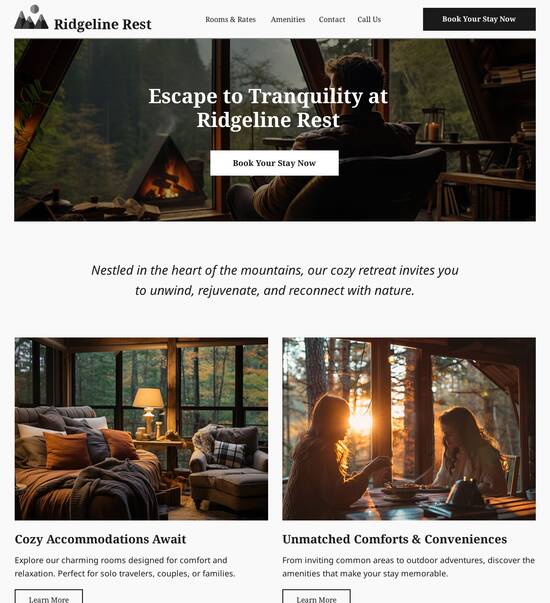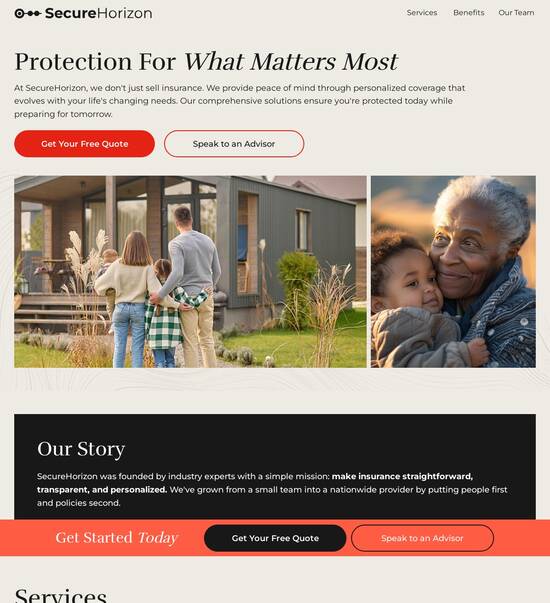
HTML page template for CRM directors
Use TemplateAbout template
Attract clients and showcase your skills with style using our landing page templates for CRM directors. Let's convert those visitors into clients!
Recommended templates

Easy to build without coding
With the intuitive drag-and-drop builder, anyone on your team can create high-converting pages without any knowledge of code or design. Make enhancements to your landing page with custom widgets using Javascript, HTML/CSS, or third-party scripts.

Multiple layouts for any industry and goal
Select from 500+ landing page layouts built to boost conversions across industry-specific scenarios. Customize them by adjusting fonts, adding images, and generating on-brand content with the AI assistant. Quickly scale with Instablocks® and Global Blocks that you can save, reuse, and update globally.

Loads fast and looks polished on any device
Every template is responsive, which means they present professionally on any device and load blazingly fast with our Thor Render Engine. You can also power them up with Google AMP technology to deliver an unparalleled mobile experience and drive higher conversions.

Robust analytics & experimentation
Get real-time updates and reporting across all your devices, showing the number of visitors, conversions, cost-per-visitor, and cost-per-lead. Launch AI-powered experiments, run A/B tests, and use heatmaps to analyze user behavior, then optimize your landing page to maximize conversions.







Easy to build without coding
With the intuitive drag-and-drop builder, anyone on your team can create high-converting pages without any knowledge of code or design. Make enhancements to your landing page with custom widgets using Javascript, HTML/CSS, or third-party scripts.
Multiple layouts for any industry and goal
Select from 500+ landing page layouts built to boost conversions across industry-specific scenarios. Customize them by adjusting fonts, adding images, and generating on-brand content with the AI assistant. Quickly scale with Instablocks® and Global Blocks that you can save, reuse, and update globally.
Loads fast and looks polished on any device
Every template is responsive, which means they present professionally on any device and load blazingly fast with our Thor Render Engine.
Robust analytics & experimentation
Get real-time updates and reporting across all your devices, showing the number of visitors, conversions, cost-per-visitor, and cost-per-lead. Launch AI-powered experiments, run A/B tests, and use heatmaps to analyze user behavior, then optimize your landing page to maximize conversions.
All the features you need to build crm html template
Explore more featuresLearn how to build crm template free download html
Frequently asked questions about crm website templates
Leading the way in building high-performing landing pages





Crm html template free: Your ultimate how-to guide
Instapage's landing page and conversion rate optimization (CRO) platform is designed to enhance your digital marketing campaigns, making it easier for marketers to accelerate results, optimize performance, and ultimately maximize ROI. This guide walks you through the key steps to successfully leverage Instapage, tailored for professionals in industries like business services, marketing and advertising, tech/SaaS, education, energy & utilities, financial services, government, and insurance across the USA.
Why choose Instapage for your landing page needs?
Instapage stands out as a comprehensive solution for creating high-converting landing pages. With over 100 pre-designed templates and lead generation elements, it's perfect for marketers looking to quickly deploy campaigns. The platform's user-friendly interface requires no coding skills, allowing for faster turnaround times without sacrificing quality.
- 100+ high-converting templates: Use ready-made designs tailored for various industries to speed up creation.
- Easy-to-use builders: Instablocks and drag-and-drop features simplify page assembly.
- Rapid deployment: Reduce time to market with intuitive navigation and fast publishing options.
Steps to create effective landing pages
The creation process can be broken down into clear steps, each crucial for driving conversions.
- Step 1 - Define your campaign goal: Be specific about what action you want visitors to take.
- Step 2 - Choose a relevant template: Ensure the design aligns with your brand's message.
- Step 3 - Customize with Instablocks: Use pre-made design elements to enhance visual appeal and user experience.
Optimizing your landing pages for higher conversions
Once your landing pages are created, continuous optimization is key to achieving better results. This involves a series of actions that assess and improve user engagement.
- A/B testing: Experiment with different headlines and CTA buttons to find what resonates best with your target audience.
- Heatmaps: Utilize analytics tools to visualize user behavior on your pages, identifying areas for improvement.
- Personalization: Deliver tailored content based on visitor information to increase relevance and engagement.
By following these steps and utilizing the powerful features of Instapage, marketers can significantly enhance their landing page performance. The platform's focus on collaboration also helps teams work together more efficiently, ensuring faster implementations and revisions as needed.
Now is the time to take your landing pages to the next level. Don’t miss out on the opportunity to boost your digital marketing efforts!
Ready to transform your campaigns? Sign up for Instapage today and start experiencing the benefits of powerful landing page creation!
People also ask about crm html template free download
The evolution of business communication: The role of HTML templates in CRM for directors
Understanding the importance of CRM directors
CRM directors play a crucial role in shaping how businesses manage customer relationships. They are primarily responsible for overseeing customer relationship management (CRM) strategies, ensuring that organizations nurture their customer base effectively. By leveraging client data and communication tools, CRM directors can enhance customer experiences and drive loyalty. Their strategic insight directly influences how companies interact with clients, setting the stage for meaningful engagements.
The responsibilities of CRM directors extend beyond just overseeing CRM software; they must analyze customer data, recognize trends, and adapt strategies accordingly. This requires not only analytical skills but also a deep understanding of customer behaviors and preferences. By developing strategies to strengthen customer connections, they can aid in achieving higher retention rates and amplifying sales.
Analyzing customer insights to drive engagement.
Overseeing the implementation of CRM systems.
Developing strategies for effective customer communication.
Working with marketing teams to align messaging.
Challenges faced by CRM directors
Every CRM director faces a myriad of challenges while managing relationships. One of the primary hurdles is balancing client outreach with the inevitable push towards automation. As technology assumes a more significant role in customer service, CRM directors must ensure that automation does not overshadow genuine human interaction. Striking that balance is critical to maintaining effective communication.
Furthermore, with the ever-increasing amount of data available, ensuring that this information is managed efficiently becomes a daunting task. Not only must CRM directors ensure data accuracy and security, but they also need to analyze it in ways that are actionable for their teams. Timely and precise communication emerges as another pressing concern; directors need to keep customers informed and engaged without overwhelming them or deploying irrelevant content.
Finding a balance between automation and personalized interactions.
Managing vast amounts of customer data effectively.
Ensuring timeliness and accuracy in customer communications.
Integrating feedback loops for continuous improvement.
The concept of HTML page templates
HTML page templates are pre-designed frameworks that can be filled with customizable data to fit various communication needs. Within CRM systems, they act as structured layouts that simplify the creation of emails, newsletters, and other communication forms. Essentially, an HTML template provides a consistent format that enhances brand identity while also being user-friendly for non-technical users.
The structure of HTML templates generally includes segments for headers, footers, and content blocks. These components can be easily manipulated to reflect the company's branding and messaging requirements. A well-designed HTML template aligns with the company's visual identity, making each piece of communication instantly recognizable to clients.
Importance of HTML templates for CRM directors
HTML templates are invaluable tools for CRM directors aiming to streamline their communication processes. They help to consolidate branding elements and ensure that every piece of outgoing content maintains a consistent look and feel. By using templates, CRM teams can cut down on the time spent designing and drafting communications, allowing for more focus on strategy and personalization.
Moreover, HTML templates enhance record-keeping by automatically tagging key communications. The utility of these templates extends beyond mere aesthetic benefits, offering a way to track engagements and responses systematically. This leads to improved organization and the ability to refer back to prior communications easily.
Key features of HTML page templates for CRM
One of the standout features of HTML page templates is their customizable structure that enhances branding efforts. Each template can be tailored to reflect the company’s visual identity. This flexibility enables CRM directors to develop specific templates for various communication needs, whether for announcements, alerts, or marketing campaigns. Such personalization strengthens brand recognition with clients.
Furthermore, integration with email systems is essential for sending campaigns effectively. Designing templates for email campaigns using HTML facilitates quick deployment while ensuring messages are visually appealing. Another essential feature is dynamic content management. CRM directors can utilize HTML to embed customer-specific data, ensuring every communication feels personalized without starting from scratch.
Customizable structure to align communications with branding.
Seamless integration with existing email marketing systems.
Ability to embed dynamic content directly into templates.
Incorporation of engaging visuals to enhance reader retention.
Enhanced user engagement through visuals
Visual elements play a key role in enhancing user engagement. Best practices for incorporating images and graphics include choosing high-quality visuals that resonate with the audience. For instance, infographics can effectively convey complex information, making it easily digestible. With well-placed visuals, the likelihood of capturing the reader's attention and holding it increases significantly.
Moreover, using visuals not only maintains user engagement but also improves retention of the information presented. Color schemes, typography, and image choices must work cohesively to reflect the brand’s values. A strong visual appeal often translates to higher open rates and click-through rates, ultimately benefiting the organization’s bottom line.
Interactive elements and call-to-actions
Creating interactive elements within HTML templates strengthens communication effectiveness. This includes clear and enticing call-to-actions (CTAs). Well-structured CTAs assist in guiding the reader toward specific actions, whether that’s visiting a website, signing up for a newsletter, or engaging with customer service. Each hyperlink embedded in the template serves as a pathway for the reader to take that next step.
Additionally, strategizing for impactful engagement involves ensuring that CTAs are placed prominently within the content. This positioning encourages interactions at key points, enhancing the potential for conversions. Such structured approaches establish a engaging flow that keeps recipients interested and prepared to act.
The benefits of using HTML templates in CRM
Utilizing HTML templates in CRM can lead to significant efficiency gains and time savings. Automated processes for repetitive communications mean that CRM teams can invest their time in developing more strategic initiatives. This efficiency allows teams to focus on more proactive customer engagement rather than getting bogged down in routine tasks.
In addition, using HTML templates ensures consistent messaging across various channels. This consistency reinforces brand identity and builds trust with clients. Teams can collaborate better when they have shared templates, adding comments and changes in real-time, which further speeds up the communication process.
Improved efficiency through automation of routine communications.
Consistent messaging across multiple communication channels.
Enhanced collaborative efforts among CRM team members.
Better tracking and analysis of customer interactions.
Enhanced record-keeping and archiving
HTML templates also play a pivotal role in enhanced record-keeping. By creating structured tables and formats, CRM directors can summarize customer interactions efficiently. Not only do these structures support better organization, they also facilitate smooth auditing processes when needed. Storing communication history becomes simplified.
The utilization of templates aids in archiving email correspondence for future reference. Key communications can be categorized and retrieved swiftly whenever necessary. This systematized approach is crucial for addressing customer queries, following up on engagements, or analyzing past strategies to foster continual improvements.
Improved customer experiences
Ultimately, enhancing the customer experience lies at the heart of every CRM director's objectives. HTML templates allow for personalized communications that resonate with individual customer needs and preferences. Tailored messaging can anticipate demands, leading to timely announcements that clients appreciate.
By segmenting clients based on their behavior and interactions, CRM directors can send relevant offers, updates, or news directly tailored to those customers. The result is an overall improvement in customer satisfaction, fostering loyalty and encouraging repeat business.
Best practices for designing HTML page templates
When designing HTML page templates, simplicity and clarity should be a priority. To create effective communication, clear text layouts and layouts promote readability. Minimizing clutter and ensuring that the design doesn’t overwhelm the content will assist readers in processing information efficiently.
Furthermore, given the rise of mobile usage, ensuring that templates are mobile-responsive is vital. Testing for usability across various devices ensures every audience segment can engage with content on their preferred devices. In addition to responsive design, engaging layouts that compartmentalize information allow readers to quickly scan for what interests them.
Prioritize simplicity in text and design hierarchy.
Ensure mobile responsiveness across different device types.
Utilize interactive elements that encourage user engagement.
Incorporate internal feedback mechanisms for continuous improvement.
Regular updates and maintenance
Regularly updating HTML templates is crucial for keeping them aligned with evolving company branding. As branding changes, templates must reflect those refinements, maintaining consistency across all communications. Templates should be revisited routinely to ensure they remain functional, relevant, and visually appealing.
Routine testing helps identify broken links or outdated information within templates. An ongoing maintenance schedule for templates will ultimately ensure that your CRM communications remain professional and effective, minimizing any potential errors that can tarnish brand reputation.
Case studies: Successful implementation of HTML templates in CRM
Exploring real-world examples provides insight into the effectiveness of HTML templates for CRM. For instance, a mid-sized company facing communication inconsistencies adopted HTML templates, allowing their CRM team to standardize outgoing messages. The result was a distinct enhancement in brand observation, leading to higher engagement levels and an increase in customer inquiries.
Another notable case involved a large enterprise that incorporated HTML templates into their multichannel strategy. By establishing a uniform communication style, they noted a significant rise in email open rates. Transitioning to personalized templates also resulted in increased customer feedback rates, which became vital for ongoing adjustments to their outreach.
Mid-sized company: Standardized messaging improved engagement.
Large enterprise: Enhanced open rates with uniform communication.
Start-up: Leveraged customization for targeted customer outreach.
Future trends in HTML template usage for CRM
Looking toward the future, the integration of AI and automation in template design is inevitable. These technologies can facilitate personalized email communications that cater to individual needs even more effectively. Integrating predictive analytics will enable CRM directors to anticipate customer behaviors and tailor communications accordingly, ensuring that marketing efforts remain relevant.
Moreover, the versatility of HTML templates will continue to expand. Ensuring that templates work seamlessly across various CRM platforms is essential for maintaining efficiency in integration. Enhanced data analytics and feedback loops will refine templates based on customer interactions, further tailoring communications in a way that aligns with changing preferences.
AI-driven personalization will shape customer communications significantly.
Cross-platform compatibility will enhance efficiency.
Advanced analytics will continually refine HTML templates.
Interactive elements may evolve toward gamification strategies.
Ready to skyrocket conversions?
Supercharge your ad campaigns with high-performing landing pages
Get started














